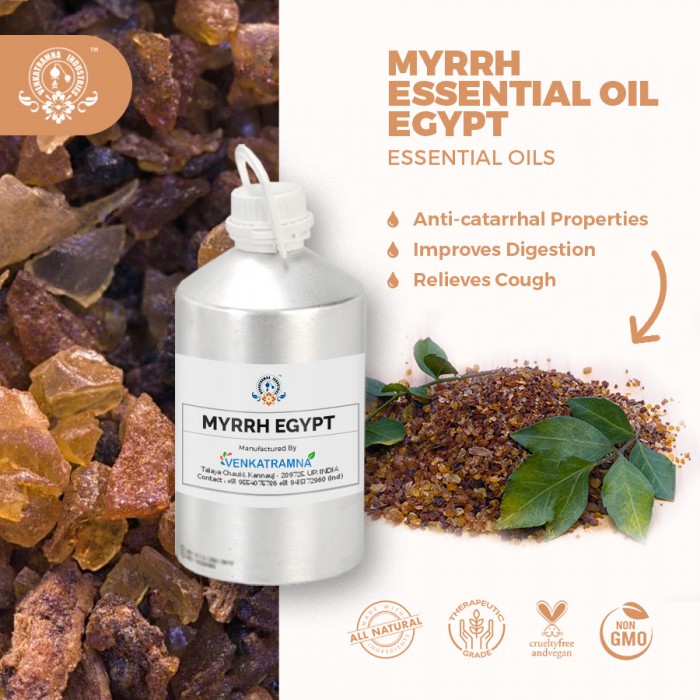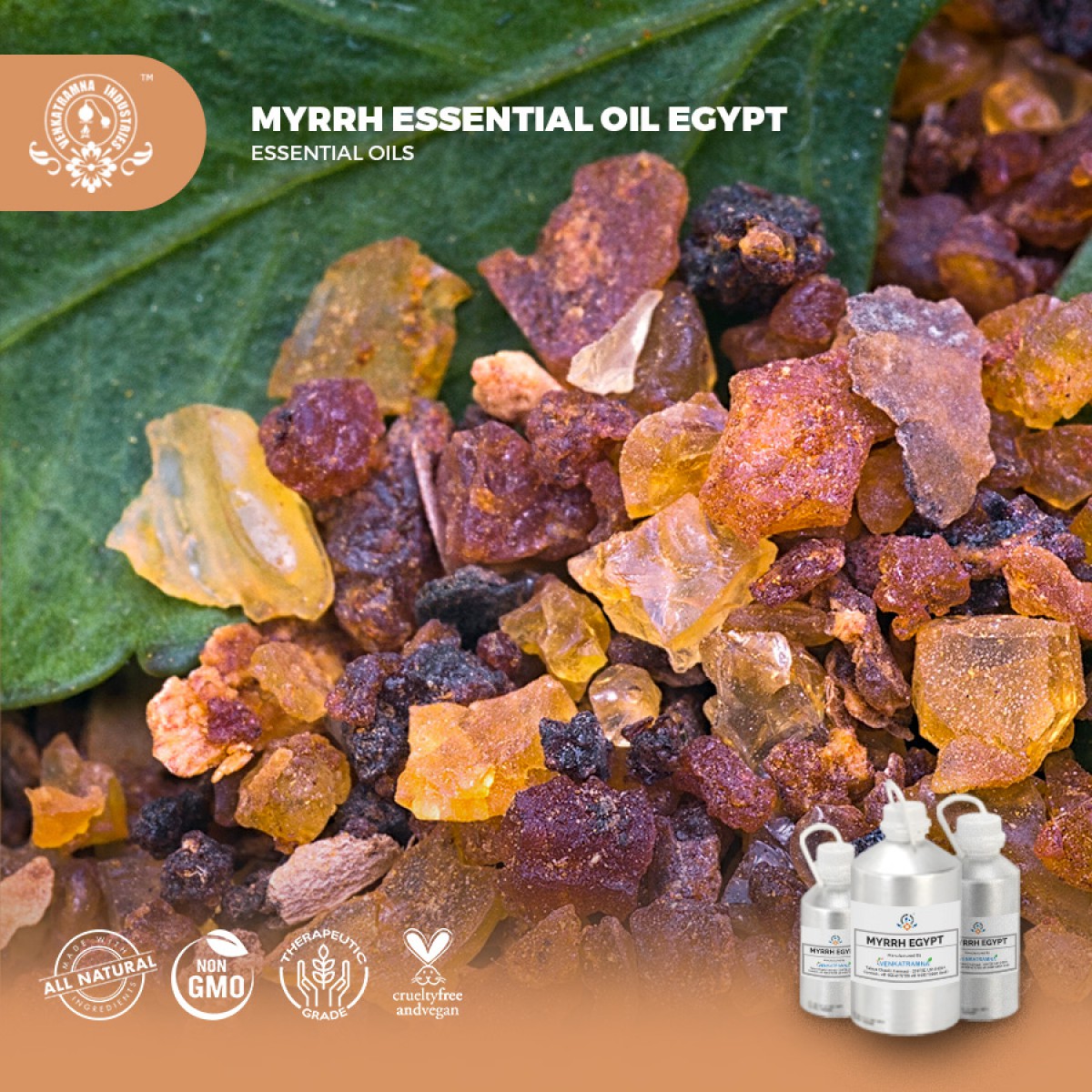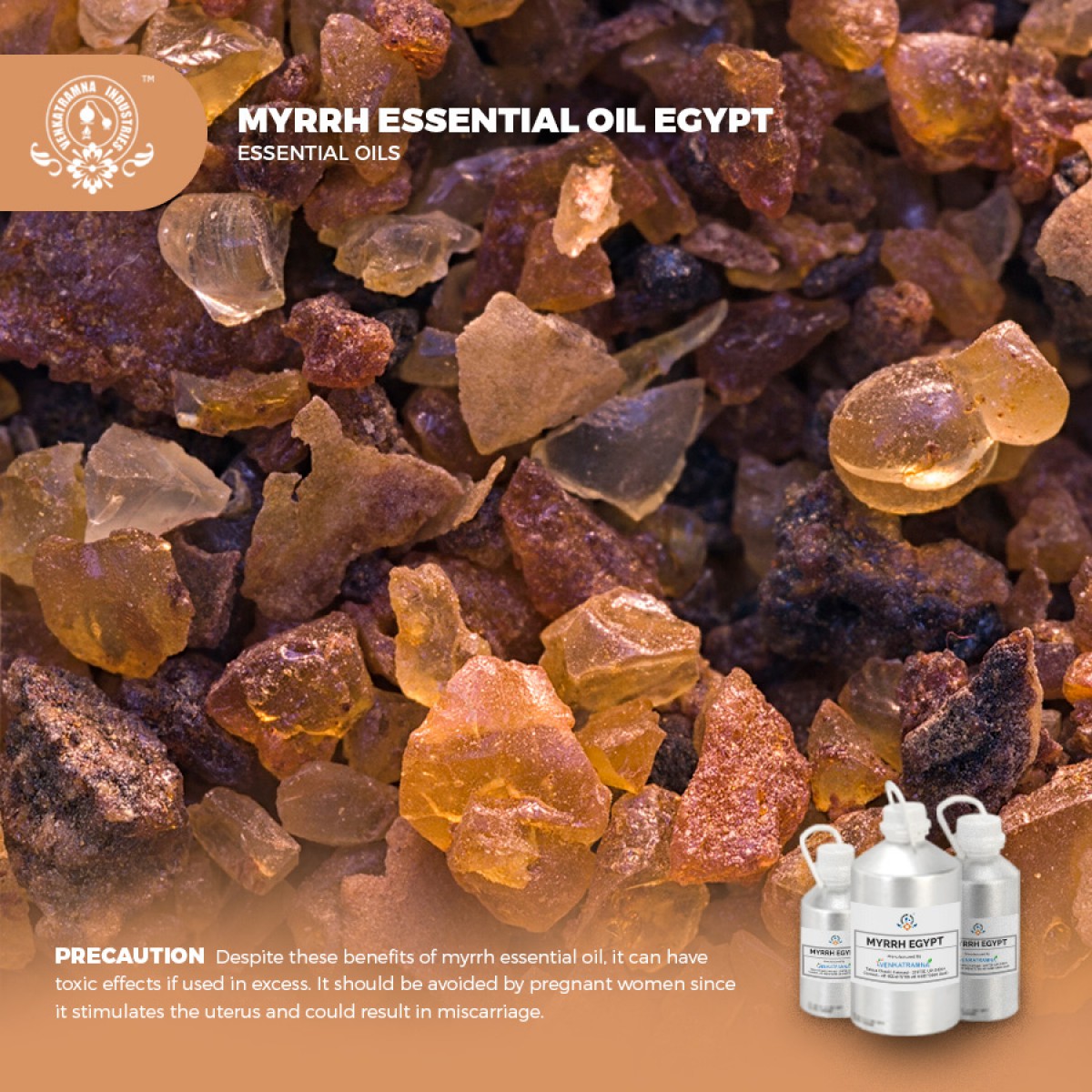Botanical Name: Commiphora Myrrha Common name: Myrrh resinoid P Read More
|
Botanical Name: |
Commiphora
Myrrha |
|
Common name: |
Myrrh
resinoid |
|
Plant
family: |
Burseraceae |
|
Genus: |
Commiphora |
|
Appearance/Color: |
Dark brown liquid with medium to viscous consistency |
|
Odor: |
Myrrh
Resinoid has a warm, rich, spicy balsamic odor with medium aroma middle note. |
|
Blends With: |
Lavender, Bay, Orange, Geranium, Clary Sage, Rosemary, Lime,
Petitgrain, Mandarin and Coriander |
|
Origin: |
Egypt |
|
Source: |
Dried gum oleoresin |
|
Method
of Extraction: |
Solvent
Extraction |
The
word "myrrh" comes from "murr," which means
"bitter" in Arabic, probably referring to the resin's bitter taste.
Myrrh was very popular among ancient cultures. The Chinese valued it as a
medicine, while Egyptians used it for embalming their pharaohs as well as for
their sun-worshipping rituals. In fact, myrrh was mentioned in Ebers Papyrus,
one of the oldest Egyptian medical texts, dating back to 1550 BC. Even the
Greek soldiers made use of this resin, bringing it with them to battle to stop
their wounds from bleeding.
The essential oil of myrrh is extracted from resin. Myrrh, in the scientific nomenclature system, is called Commiphora Myrrha and is native to Egypt. The resin was frequently used in incense and perfumes in ancient Egypt, and the oil obtained from it was used for healing wounds in ancient Greece.
DISCLAIMER
The complete range of conditions
or methods of use are beyond our control therefore we do not assume any
responsibility and expressly disclaim any liability for any use of this
product. Information contained herein is believed to be true and accurate however,
all statements or suggestions are made without warranty, expressed or implied,
regarding accuracy of the information, the hazards connected with the use of
the material or the results to be obtained from the use thereof. Compliance
with all applicable federal, state, and local laws and local regulations
remains the responsibility of the user.
The FDA has not evaluated the
statements on this website. No claims are made by Venkatramna Industries as to
the medicinal value of any products from vriaroma.com or by us. The information
presented here is for educating our customers about the traditional uses of
essential oils and is not intended to diagnose, treat, cure, or prevent any
disease. You are responsible for understanding the safe application of these products.
If you have any questions, please call or email us for further information.
As per NAHA guidelines, New Directions Aromatics
(NDA) does not recommend the ingestion of essential oils. It is imperative to
consult a medical practitioner before using Essential Oils for therapeutic
purposes. Pregnant and nursing women and those taking prescription drugs are
especially advised not to use this product without the medical advice of a
physician. The oil should always be stored in an area that is inaccessible to
children, especially those under the age of 7.
For its
numerous versatile uses, Myrrh has become one of the most extensively used
essential oils around the world. For centuries, it has been used by many
cultures in traditional medicine, religious observances, fumigation, culinary
applications, funeral rites, purification rituals, and perfumery. Myrrh
Essential Oil remain relevant today for many of the above mentioned uses and
especially for cosmetic applications, due to their cleansing, brightening,
soothing, and rejuvenating properties.
Myrrh Essential Oil is popular in aromatherapies, and is well known to
offer relief for colds, congestion, coughs, bronchitis, and phlegm. Inhaling
its sedative scent is known to lift negative moods, promote the feeling of
being grounded, and encourage the feeling of spiritual awakening.
Myrrh Essential Oil strengthens the muscles and smooths the skin while
promoting relaxation. Its anti-inflammatory and anti-oxidant properties address
symptoms of indigestion and prevent toxins from accumulating in the circulatory
system.
When
applied externally, Myrrh Essential Oil
facilitates the fading of unwanted blemishes on the skin, soothes itchiness,
and reduces symptoms of eczema among other skin ailments. It effectively
cleans, moisturizes, and tightens the skin, thereby reducing and preventing
further chapping, cracking, and sagging.
Myrrh Essential Oil’s astringency strengthens the roots and thus reduces
hair loss. Along with addressing dandruff, its scent also stimulates the brain,
promotes alertness, and boosts energy.
Myrrh Essential Oil facilitates the healing of wounds by protecting them
from infection and by calming tissue inflammation. Its astringent property
helps prevent wounds from haemorrhaging, thus preventing excessive blood loss.
With emmenagogue properties, Myrrh Oil is known to regulate menstruation and to
ease its negative symptoms, such as hormonal imbalances that lead to mood
swings.
COMMON
USAGE
·
Relieves
Cough
·
Improves
Digestion
·
Anti-catarrhal
Properties
·
Increases
Perspiration
·
Speeds
up Healing
·
Boosts
Immunity
·
Anti-inflammatory
Properties
·
Astringent
Properties
·
Stimulates
the Nervous System
·
Fights
Fungal Infections
·
Inhibits
Microbial Growth
Ingredients:
|
S.No |
Key Constituents |
Strength (%) |
|
1 |
Furanoeudesma-1,3-diene |
36.0 |
|
2 |
Furanodiene |
20.2 |
|
3 |
Lindestrene |
13.10 |
|
4 |
b-Elemene |
9.5 |
|
5 |
Germacrene B |
3.8 |
|
6 |
Germacrene D |
3.7 |
|
7 |
d-Elemene |
3.2 |
|
8 |
2-Methoxyfuranodiene |
2.4 |
|
9 |
Isofuranogermacrene(curzeree) |
2.5 |
|
10 |
T-Cadinol |
1.7 |
|
11 |
b-Caryophyllene |
1.5 |
|
12 |
b-Bourbonene |
1.1 |
|
13 |
g-Cadinene |
1.4 |
|
14 |
Furanoeudesma-1,4-diene |
2.01 |
|
15 |
g-Elemene |
1.1 |
Safety Summary
·
Hazards: May be fetotoxic, due to
b-elemene and furanodiene content.
·
Contraindications (all routes):
Pregnancy, lactation.
Organ-specific
effects
·
Adverse skin reactions: Undiluted
myrrh oil was not irritating to mice or pigs; tested at 8% on 25 volunteers it
was neither irritating nor sensitizing. Myrrh oil is not phototoxic. Myrrh oil
was concentration-dependently irritating to the ear of albino mice, causing
irritation in 12/12 animals at 0.1 mg/mL and 4/12 animals at 0.15%. A
65-yearold aromatherapist with multiple essential oil sensitivities reacted to
both 1% and 5% myrrh oil.
·
Reproductive toxicity: The administration
of a combination of myrrh resin and essential oil to pregnant rats at 50–200 mg/kg/
day on gestational days 6–15 did not increase abnormalities of the fetal
skeleton. Both furanodiene and b-elemene are antiangiogenic. In view of the
probable link between antiangiogenic effects and reproductive toxicity, have
contraindicated myrrh oil in pregnancy and lactation.
·
Hepatotoxicity: A single oral dose of
12.5, 25 or 50 mg/kg of furanodiene dose-dependently protected mice against
liver injury induced by D-galactosamine/lipopolysaccharide or TNF-a.
Systemic
effects
·
Acute toxicity: Myrrh oil acute oral LD50
in rats: 1.65 g/kg.
·
Antioxidant/pro-oxidant activity: The
essential oil from Somalian Commiphora myrrha displayed an antioxidant activity
against singlet oxygen greater than that of ()-a-tocopherol. Singlet oxygen is
a major player in lipid peroxidation, phototoxicity and DNA degradation.
·
Carcinogenic/anticarcinogenic potential:
No information was found for myrrh oil, but it contains no known carcinogens.
Furanodiene demonstrated an in vitro anticarcinogenic action against human
liver cancer cells by preventing tumor cell growth and inducing apoptosis.
Furanodiene inhibited proliferation of six cancer cell lines with IC50 values
of 0.6–4.8 mg/mL, and of uterine cervical and sarcoma tumors in mice. b-Elemene
displays anticarcinogenic activity.
Health
Hazards (Acute & Chronic):
·
Ingestion of large quantities: None
established
·
Inhalation: None established
·
Skin Contact: Liquid may be irritating
·
Eye Contact: Liquid may be irritating
·
Ecotoxicity: no data available
·
Bioaccumulation: No data available
·
Mobility in soil: No data available
·
Persistence and degradability: No data available
·
PBT and vPvB assessment: No data available





 PS-Myrrh.pdf
PS-Myrrh.pdf




